Different Period Blood Colors: What it Means for Your Health
What is a normal period?
A period is where a woman bleeds through her vagina as her the innermost layer, called the endometrium, of the uterus sheds its lining. This happens because the uterus prepares itself as a cushion for possible implantation after the fertilization of an egg. And if an egg is not fertilized, all the cushioning lining of the uterus is shed along with the unfertilized egg, this is what a period is. Normally, a girl experiences her first period at an average age of 12 to 13. This cycle lasts for at least 30 to 35 years and ends in the 5th decade of life. This entire phenomenon is controlled by an extensive and typical communication of hormones inside a woman body which explains the variability woman gets in her periods during her life at different stages.
What do different period blood colors mean for your health?
We need to understand that period blood is different from the blood in the rest of your body. Because the period blood happens as a result of uterine shedding its linings and controlled by an array of hormones, the period blood is rather thicker and as it makes its way out of the vagina it gets mixed with mucus and other body cells. The consistency is also different from the blood in the rest of the body, and even the color may vary.
The period blood also presents in different colors that vary from woman to woman, in fact, it can vary from one period blood from the next period blood in the same woman, this is mainly because of the hormones involved, that regulate your cycle and uterine shedding every month.
And even though many women might find a period blood color changing concerning, it is not concerning most of the times, but the color of your period blood can tell a lot about your reproductive health and some colors may lead to some diagnoses. The common colors that a period blood might be of, include:
Bright red period blood:
It is the most common period blood color in a person. If you see bright red color of your period blood then it means it is the freshest blood that entered the uterus and without any ado, left the uterus through the cervix which is why it did not get to stay in the uterus long enough for it to get oxidized and change its color.
Even though bright red is a common color, it is also associated with other conditions which may be a:
o pregnancy. Even though pregnancy period color may vary, but if you see spotting with a missed regular period, it is a sign that you may be pregnant.
o Miscarriage. If you find that you are bleeding once you had your pregnancy confirmed, then heavy bleeding could indicate a miscarriage.
o Fibroids or polyps. It is a benign growth in the layers of the uterus, which can easily be treated medically and surgically. Fibroids can make you have heavier periods than your normally had, or even have more than one period in a month. You may also experience a nagging feeling in your pelvic region. If you notice any of these symptoms then you need to visit your doctor as soon as possible.
o Infection. An infection from organisms like chlamydia or gonorrhea can also make you bleed in between your two periods, naturally, it becomes essential for you to visit your doctor.
How To Shorten Your Period – Very Effective Natural Ways
Black period blood:
You may get worried reading the words ‘black blood’. Do not worry, it is has nothing to do with how scary it sounds. Black blood is very common and very normal to have. Black period blood only means that the blood that had to leave your uterus has stayed in your uterus a little longer than it should have or your blood flow is slower than normal. And since it has stayed longer, it has gotten oxidized for a longer time, which caused it to become black. It can only mean that the black period blood is the sort of blood that had accumulated while during the cycle and may present at the start or the end of the period.
Black blood can also represent incomplete shedding of the uterine lining. Sometimes, the uterus does not expel all the blood out completely, therefore, the blood that never got the chance to leave stays in the uterus till the next time you get a period for it to leave your body. This is also where your period blood may look black.
Dark red period blood:
Apart from the blood getting oxidized due to longer stay in the uterus, another condition can present itself with dark red period blood known as lochia. This type of blood is most commonly seen after a woman delivers her baby, and is heavier than regular periods and may also include clots.
Orange period blood:
The most common health sign associated with orange blood is an early vaginal infection. It includes infections that can be bacterial, viral and sexually transmitted infections (STIs). Along with having orange period blood color, there may be other signs and symptoms of vaginal infection that are:
o Itching
o Redness
o Unusual discharge with a foul smell
o Pain in the lower abdomen
o Pain during intercourse
In other cases, orange blood also means that the regular period blood has mixed with the cervical mucus or fluid and presents this way, and this is completely normal to have.
Related: I Feel Like I Have My Period But No Blood-15 Reasons Why Got Period Symptoms But No Period
Pink period blood color:
Just like how a woman gets orange period blood, pink period blood may also somewhat mean the same. Getting pink period blood is associated with light spotting that you may find in the start on your periods or towards the end. You may also see pink period blood in your mid-menstrual cycle that is known as the ovulation bleeding. This occurs when your ovaries have released an egg, hence, you experience very little spotting that could be of pink in color or gives it a pink hue.
Pink period blood can also mean low estrogen in your body. Estrogen is a hormone released by the ovaries that play a very crucial role in your period regulation and development of a girl’s secondary characteristics. Many factors can lead to a deficiency of estrogen hormone in a woman. Whatever may be the reason, low estrogen means your uterus was not able to release an egg nor was it able to prepare the blood lining that could have been shed in your period blood. And when this happens, you get lighter periods than normal or just maybe spotting.
On the other hand, if you know you are pregnant and you get heavy bleeding that is pink in color, it could very likely mean that you have miscarried. Miscarriage is associated with other symptoms like pain in the pelvic region, cramps and dizziness.
PERIOD CRAMPS: Why Am I Cramping A Week Before My Period?
Brown period blood:
Brown blood is mostly because of the same reasons as dark red or black blood, which is because the blood has stayed in your uterus longer and got so oxidized and old that is turned brown, black or dark red. These colors are just variation of the old blood in the uterus.
But if you find that you are spotting and the color is brown, then the most common thing regarded with it is implantation bleeding or spotting. Most women may get worried that they did not proper periods or that the color was different from their usual period blood color because it is easy to mistake the implantation bleeding as periods. Otherwise, brown color of the blood can be counted as lochia, which is the blood that is expelled out from the uterus after the delivery of a baby. Similarly, it can also mean that you may have a miscarriage.
Gray period blood:
Gray blood is very unusual to have and is an ominous sign of a vaginal infection strictly because of a condition known as Bacterial Vaginosis. This infection is very common in women of childbearing age and especially those women who are sexually hyperactive with many sexual partners, though it is not a sexually transmitted disease. Other symptoms of this infection may include whitish discharge, foul smell, itching or burning sensation. If any of such symptoms worry you, then it is time to speak with a doctor about this.
Related: CHANGES IN MENSTRUAL CYCLE AGE WISE
References:








2 Replies to “Different Period Blood Colors: What it Means for Your Health”